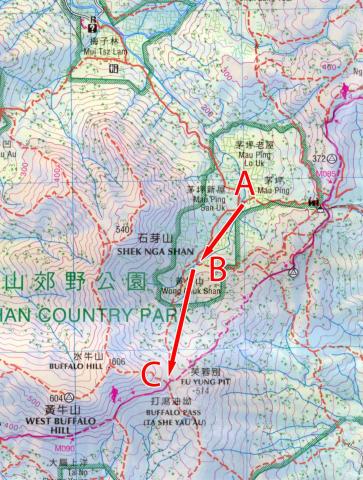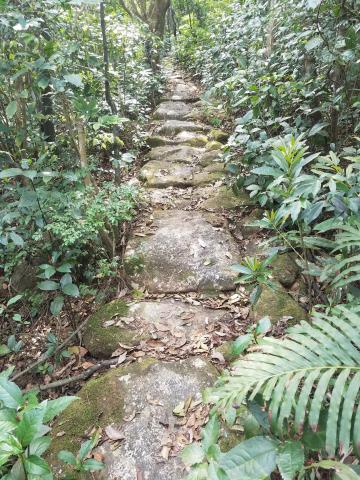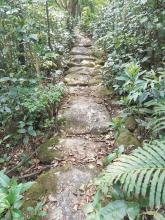(Switch to the OSM map to get a better view of the footpaths in this area.)
Named after: This track passes through the ruins of Wong Chuk Shan village.
Timeline:
- 1???: The year that Wong Chuk Shan village was settled may give an idea of when this track was built.
Directions: The map below is copied from the Sai Kung & Clear Water Bay sheet of the Countryside series of maps. The path starts at A, where the main Mui Tsz Lam - Sai Kung path crosses a bridge. To follow this path, don't cross the bridge, instead follow the path to the right, up the valley. At B you'll pass through the ruins of Wong Chuk Shan village, and some impressive dry-stone retaining walls. At C you'll reach the Maclehose Trail.
The B-C section of the track is marked with a dotted line, which the key says means "difficult / indistinct or seasonally overgrown". I was expecting a difficult walk, trouble finding the path, and lots of crashing through bushes. In fact the path is in good shape, and is a clear walk (there are a few trees that have blown down across the path in typhoons, but they are easy to clamber over). Here's a view of the top section of the path, not far from C.
We walked this track as part of a circular walk, starting and ending at Siu Lek Yuen.
Other points of interest:




Comments
Wong Chuk Shan boulder trackway [????- ]
This location is cited in Owen and Shaw (2001), Hong Kong Landscapes: Along the MacLehose Trail: Geotrails Society. Pages 96 and 97 give a contemporary photograph and a map of similar locations of boulder /paved trackways, including a 'very well constructed paved trackway " between Mui Tsz Lam in the Sha Tin Valley and Uk Cheung above Sai Kung Town.
Owen and Shaw (2001) commented: "Many of these routes were originally built in the reign of Cheng Lung (1736-1796AD). ... The stones used in their construction are mostly well-cut, reflecting the traditional stonemason skills of the Hakka population."
Thanks for that - it's good
Thanks for the extra information - it's good to get a better idea of how old they are.
Re Boulder tracks
Hi There,
One has to walk through one of these in order to appreciate how well it was designed and built. Literally speaking, you do not have to lift your foot like going up stairs. This is essential for village dwellers carrying heavy\bulky goods travelling between their villages and market places with minimal effort.
It is going to be expensive and labour intensive, but I wish the Government departments would consider using these kind of engineering in future country park tracks when it is time for overhaul. I do not like walking on concrete paths.
T